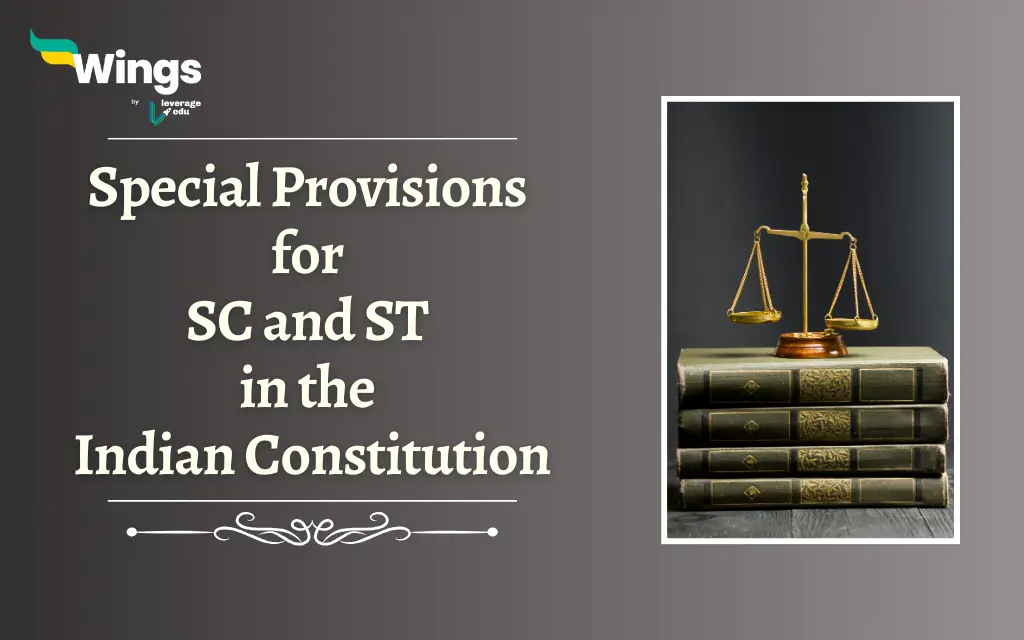The Indian Constitution does not provide a specific list of castes or tribes categorized as Scheduled Castes (SCs) or Scheduled Tribes (STs). Instead, it grants the President of India the authority to identify these communities within each State and Union territory. Moreover, this results in variations in the SC and ST listings across different regions. In addition, for States, the President issues a report after consulting the State Governor. However, only the Indian Parliament can include or exclude castes or tribes from this list, not a presidential report. Furthermore, the President has given orders specifying SCs and STs in different States and Union territories, and these orders can be amended by Parliament. Read on to learn more about the 4 Special Provisions for SC and ST in the Indian Constitution.
Contents
1. Representation for Scheduled Castes and Scheduled Tribes in Legislatures
The Indian Constitution guarantees representation for Scheduled Castes (SCs) and Scheduled Tribes (STs) in the Lok Sabha and State Legislative Assemblies.
- A specific number of seats are reserved for these communities based on their population ratios.
- This reservation policy was initially implemented for ten years, ending in 1960.
- However, it has been continuously extended ever since, usually in ten-year increments.
- The most recent extension by the 104th Amendment Act of 2019, guarantees continued reservation for SCs and STs until 2030.
Also Read: 15 Constitutional Provisions for Judicial Review in India
2. Considering Claims of Scheduled Castes and Scheduled Tribes in Public Service Appointments
The Indian Constitution directs the claims of Scheduled Castes (SCs) and Scheduled Tribes (STs) to be given due consideration:
- This guarantees their representation in public services at the Central and State levels, while still maintaining administrative efficiency.
- However, the 82nd Amendment Act of 2000 allows for additional measures to support SCs and STs.
- Moreover, these may include relaxation of qualifying marks in exams or adjustments in evaluation standards.
- In addition, the Amendment also allows reservations for promotions within the public services.
Also Read: All the Emergency Provisions in the Indian Constitution
3. Two National Commissions Protect Marginalized Groups in India
The Indian Constitution orders the establishment of two National Commissions to protect the interests of historically disadvantaged communities.
- National Commission for Scheduled Castes (NCSC): Under Article 338, the NCSC analyses matters about constitutional protections for Scheduled Castes.
- Moreover, it reports its findings and recommendations to the President of India.
- National Commission for Scheduled Tribes (NCST): The 89th Amendment Act of 2003 in the NCST has a similar function for Scheduled Tribes (STs) as outlined in Article 338A.
- Additionally, it reports to the President and guarantees compliance with constitutional protection for ST communities.
Earlier, a single commission addressed the needs of both SCs and STs. However, the 89th Amendment recognized the particular requirements of these groups and established separate commissions. The President submits the reports of both Commissions to Parliament, along with a memorandum detailing actions taken based on their recommendations.
Also Read: What is Doctrine of Severability?
4. The Union’s Role in Scheduled Areas and Tribal Welfare
The Indian Constitution gives the central government, or the Union, specific powers regarding Scheduled Areas and Scheduled Tribes:
- Commission for Review: The President has the authority to appoint a Commission to evaluate the administration of Scheduled Areas and the well-being of STs within States.
- Consequently, this can be done at any time, but it is compulsory every 10 years after the Constitution’s commencement.
- Historical Commissions: The first commission was established in 1960 under U.N. Dhebar, submitting its report in 1961.
- Moreover, four decades later, a second commission led by Dilip Singh Bhuria was formed in 2002, thus reporting its findings in 2004.
- Central Government’s Directives: The Union also has the Executive power to give directions to State governments.
- These directives can focus on formulating and implementing programs specifically designed to improve the welfare of STs within each State.
Related Blogs
| What is Doctrine of Severability? | What is the Doctrine of Colourable Legislation? |
| What is the Doctrine of Colourable Legislation? | What is the Concept of the Gujral Doctrine? |
| Difference between Doctrine of Eclipse and Severability | What is the Difference between Fundamental Duties and Directive Principles? |
| What is Universal Adult Franchise? | What is the Difference Between Fundamental Rights and Fundamental Duties? |
Lastly, we hope you liked our blog and gained an understanding of the Special Provisions for SC and ST in the Indian Constitution. Moreover, you may even read more blogs and empower yourself with knowledge regarding Civics and Polity!
 One app for all your study abroad needs
One app for all your study abroad needs














